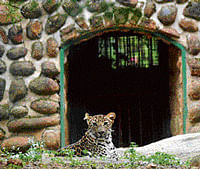
The Bannerghatta Biological Park (BBP), which includes the Reserve Forest, is no longer a safe haven for its flora and fauna, a study has found. The culprit: Bangalore’s burgeoning population and the resultant increase in demand for land and resources.
The recent proposal by the tourism department to start night safari can only add to the pressure on the park’s fragile ecosystem, a study by P U Anthony, Professor and Head of the Department of Zoology, Christ University, has found.
According to the study, BBP is slowly turning into an ‘eco-tourism hotspot,’ thereby eating into the natural habitat of the animals.
“The Reserve Forest and the park area are not well protected and have weak ends, with discontinued solar fencing on its peripheries. People enter illegally into the park and sometimes recreational activities are conducted on weekends, without the consent of the forest department. Frequent wildlife surveys and vegetation studies, involving the public, are being undertaken by private agencies. These are strictly against conservation policies,” Anthony said.
Awareness programme
During the 'Wildlife Week,’ an awareness programme to protect wildlife was organised by the forest department. Participants were allowed to venture into the forest wearing white T-shirts and caps, which is unfriendly for any nature trial. "When you are in the forest area, ideally green or the olive green military costume is recommended to camouflage with the forest environment. People wearing white will attract the attention of the animals in the forest," he said.
No buffer zone
Due to the absence of buffer zone between agricultural lands and forest area (except along the South Eastern boundary), people living close to the park graze their cattle in and collect firewood from the forest.
They have not been educated about the responsibility of conserving the wildlife and its habitat. Activities like smuggling of wood and grazing are not being monitored by the forest department.
Moreover, a few farmers have connected the fencing around the farmlands to high voltage power, leading to electrocution of elephants and other animals.
Improvements in civic amenities like tarred roads, frequent bus services and mushrooming of educational institutions around the forest area have increased the threat to the forest.
Healthcare facilities have increased activities close to the park. Also, there are no legal restrictions on the luxury resorts, which are sprouting around the park area, says the study.
The population growth was 12.21 per cent in Bangalore Rural district and 34.8 percent in Bangalore Urban district between 1991 and 2001. There are 86 villages falling within the 'Zone of Impact,' which is one kilometre from the boundary of the park.